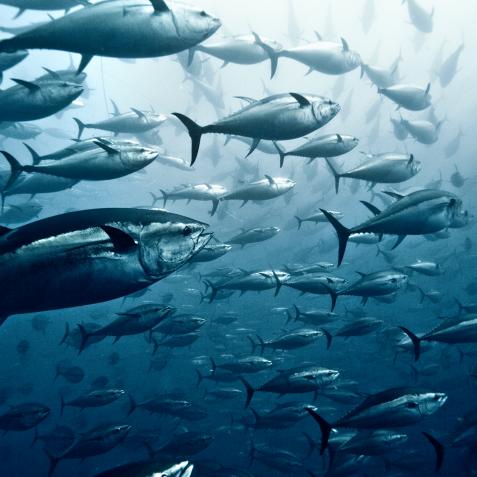
Ethan Daniels/Stocktrek Images
Whale and Krill Populations are the Secret to Healthier Oceans
Oceans rely on their largest species, especially whales, to recycle and regenerate ecosystems. Studies at Stanford University identify the whale as an animal that recharges its own food sources and recycles carbon. Now researchers think they have found a way to seed plankton and krill numbers that will boost whale populations and restore fading sea life.
Krill is the chief food source of baleen whales including the blue whale. Reddish in appearance, the tiny crustaceans are swallowed in vast quantities by the whales, sieved out of seawater using the bristly baleen plates in their mouths.
Whales in turn sustain phytoplankton – a vital food source for krill, small fish, and crustaceans – by eating krill and then defecating. This releases iron in the whale’s krill diet back into the water to boost both phytoplankton numbers and krill. Healthy whale populations support the recycling of resources and if numbers drop it has a negative impact.
.jpg.rend.hgtvcom.861.574.suffix/1638303411671.jpeg)
Roger Tidman
Researcher Matthew Savoca of Stanford’s Hopkins Marine Station studied feeding data from baleen whales – blue, fin, humpback, and minke – and found that they eat at least twice as much krill as previously thought. Blue whales can eat up to 16 metric tons per day – with each gulp their mouths can swell to gather up a volume of water larger than their own body.
Using drones to photograph and measure feeding whales, and echo sounders to size up krill swarms, Savoca and his team estimated that before commercial whaling, baleen whales would have eaten around 430 million metric tons of krill each year. By comparison that is more than twice the worldwide annual fish and seafood caught today.
Whale populations are only now recovering from centuries of hunting and re-establishing an essential role in ocean health. But many species including six out of the 13 baleen species are still endangered.

by wildestanimal
Baleens were killed on an industrial scale for their meat, oil, and whalebone. The arrival of explosive harpoons and factory ships, which stripped whale carcasses at sea, in the twentieth century massively impacted their numbers. Between 1910 and 1970 around 1.5 million baleen whales were caught and killed in Antarctic waters.
In six decades the blue whale population was reduced from 360,000 to 1,000. After the US banned commercial hunting in 1971 and the International Whaling Commission (IWC) followed in 1982, whale numbers recovered slowly. The IWC estimates there are 1.7 million whales total with between 5,000 and 10,000 blue whales.
Accelerating their recovery should have been a ready over-supply of krill-rich waters, hundreds of millions of tons of their favorite food. Instead, the decline of baleen whales also impacted krill numbers. Factors like climate change and commercial overfishing have further reduced krill populations by 80 percent since the 1970s.
Savoca said the drop-off in whale numbers badly affected all ocean ecosystems including the food they rely on. “Fifty years after we stopped hunting whales, we’re still learning what impact that had. The system is not the same.”

boonchai wedmakawand
Whales are ecosystem engineers because the way they eat supports the ocean food web. As well as recycling nutrients from krill, they dive to bring nutrient-rich deep water to the surface, and when they bottom-feed they stir up sediments and crustaceans that other species eat. Finally, when they die their carcasses are food for a rich variety of creatures including killer whales, sharks, fish, and ocean floor organisms including invertebrates and bacteria.
All of the whale’s productive input could be realized again, according to the Stanford research group, if phytoplankton and krill are stimulated using one simple input: iron. Adding iron particles, it said, could stimulate plankton blooms, and their growth would, in turn, soak up carbon dioxide and fuel krill populations.
Stimulating krill in areas where whale numbers are recovering would positively boost local food webs and lead them to self-regenerate – a form of rewilding. The team is planning a small, controlled experiment to see if adding precise amounts of ironworks, based on their data showing how much krill whales actually eat.
If they are successful it could begin to mend a hole created by human plundering of one of the ocean’s most important species, restoring some balance. These giants of the sea are responsible for recycling carbon and sustaining ocean food chains. In effect, healthy whale populations make a healthier planet.











.jpg.rend.hgtvcom.476.476.suffix/1635892481978.jpeg)






